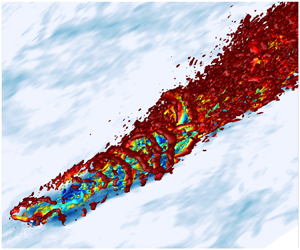Crossref Citations
This article has been cited by the following publications. This list is generated based on data provided by
Crossref.
Chen, Danyang
Zhou, Zhideng
and
Yang, Xiaolei
2022.
A measure–correlate–predict model based on neural networks and frozen flow hypothesis for wind resource assessment.
Physics of Fluids,
Vol. 34,
Issue. 4,
Yang, Haoze
Ge, Mingwei
Gu, Bo
Du, Bowen
and
Liu, Yongqian
2022.
The effect of swell on marine atmospheric boundary layer and the operation of an offshore wind turbine.
Energy,
Vol. 244,
Issue. ,
p.
123200.
Li, Quanzheng
Chen, Xin
Wang, Gang
and
Liu, Yi
2022.
A dynamic version of the improved delayed detached-eddy simulation based on the differential Reynolds-stress model.
Physics of Fluids,
Vol. 34,
Issue. 11,
Xiong, Xue-Lu
Laima, Shujin
and
Li, Hui
2022.
Asymmetries and similarities of yawed rotor wakes.
Physics of Fluids,
Vol. 34,
Issue. 10,
Li, Zhaobin
Dong, Guodan
and
Yang, Xiaolei
2022.
Onset of wake meandering for a floating offshore wind turbine under side-to-side motion.
Journal of Fluid Mechanics,
Vol. 934,
Issue. ,
Posa, A.
Broglia, R.
and
Balaras, E.
2022.
Recovery in the wake of in-line axial-flow rotors.
Physics of Fluids,
Vol. 34,
Issue. 4,
He, Xinyi
and
Yang, Xiaolei
2022.
Effects of exercise on flow characteristics in human carotids.
Physics of Fluids,
Vol. 34,
Issue. 1,
Vahidi, Dara
and
Porté-Agel, Fernando
2022.
A New Streamwise Scaling for Wind Turbine Wake Modeling in the Atmospheric Boundary Layer.
Energies,
Vol. 15,
Issue. 24,
p.
9477.
Li, Jinlu
Yu, Yanghai
and
Zhu, Weipeng
2022.
Nonuniform dependence on initial data for the 2D viscous shallow water equations.
ZAMM - Journal of Applied Mathematics and Mechanics / Zeitschrift für Angewandte Mathematik und Mechanik,
Vol. 102,
Issue. 6,
Li, Shilong
Yang, Xiaolei
and
Lv, Yu
2022.
Predictive capability of the logarithmic law for roughness-modeled large-eddy simulation of turbulent channel flows with rough walls.
Physics of Fluids,
Vol. 34,
Issue. 8,
Dong, Guodan
Li, Zhaobin
Qin, Jianhua
and
Yang, Xiaolei
2022.
Predictive capability of actuator disk models for wakes of different wind turbine designs.
Renewable Energy,
Vol. 188,
Issue. ,
p.
269.
Li, Baoliang
He, Jia
Ge, Mingwei
Ma, Hongliang
Du, Bowen
Yang, Haoze
and
Liu, Yongqian
2022.
Study of three wake control strategies for power maximization of offshore wind farms with different layouts.
Energy Conversion and Management,
Vol. 268,
Issue. ,
p.
116059.
Dong, Guodan
Li, Zhaobin
Qin, Jianhua
and
Yang, Xiaolei
2022.
How far the wake of a wind farm can persist for?.
Theoretical and Applied Mechanics Letters,
Vol. 12,
Issue. 1,
p.
100314.
Li, Zhaobin
Liu, Xiaohao
and
Yang, Xiaolei
2022.
Review of Turbine Parameterization Models for Large-Eddy Simulation of Wind Turbine Wakes.
Energies,
Vol. 15,
Issue. 18,
p.
6533.
Liu, Xiaohao
Li, Zhaobin
Yang, Xiaolei
Xu, Duo
Kang, Seokkoo
and
Khosronejad, Ali
2022.
Large-Eddy Simulation of Wakes of Waked Wind Turbines.
Energies,
Vol. 15,
Issue. 8,
p.
2899.
Li, Jinlu
Deng, Wei
and
Li, Min
2022.
Non-uniform dependence for higher dimensional Camassa–Holm equations in Besov spaces.
Nonlinear Analysis: Real World Applications,
Vol. 63,
Issue. ,
p.
103420.
Li, Yunliang
Li, Zhaobin
Zhou, Zhideng
and
Yang, Xiaolei
2023.
Large-Eddy Simulation of Wind Turbine Wakes in Forest Terrain.
Sustainability,
Vol. 15,
Issue. 6,
p.
5139.
Wang, Xiu
Yan, Yan
and
Wang, Wen-Quan
2023.
Transient starup performance of a micro horizontal axis river hydrokinetic turbine.
Ocean Engineering,
Vol. 287,
Issue. ,
p.
115872.
Zhao, Mengshang
Chen, Siqi
Wang, Kai
Wu, Xiaodi
and
Zha, Ruosi
2023.
Effect of the yaw angle on the aerodynamics of two tandem wind turbines by considering a dual-rotor wind turbine in front.
Ocean Engineering,
Vol. 283,
Issue. ,
p.
114974.
Tu, Yu
Zhang, Kai
Han, Zhaolong
Zhou, Dai
and
Bilgen, Onur
2023.
Aerodynamic characterization of two tandem wind turbines under yaw misalignment control using actuator line model.
Ocean Engineering,
Vol. 281,
Issue. ,
p.
114992.



